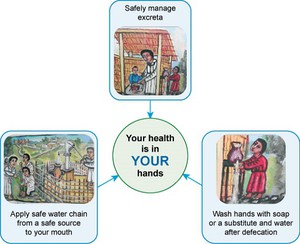National Hygiene and Sanitation Strategy
The National Hygiene and Sanitation Strategy (NHSS) was developed by the Ministry of Health and published in 2005. It was designed to complement the existing Health Policy and Water Sector Strategy. Figure 2.6 shows the image on the front cover of the document.

Figure 2.6 Image from the cover page of the National Hygiene and Sanitation Strategy. (MoH, 2005)
What message is conveyed by the front cover image shown in Figure 2.6?
The three pictures represent the three elements of WASH: safe water supply, sanitation, and hygiene, and shows that all three have a direct impact on personal health.
The Strategy starts with a ‘Sanitation Vision for Ethiopia’, which is ‘100% adoption of improved (household and institutional) sanitation and hygiene by each community which will contribute to better health, a safer, cleaner environment, and the socio-economic development of the country’ (MoH, 2005). The Strategy first describes the current situation (as it was in 2005), and then sets out objectives and plans for achieving the goal of the Vision Statement. It puts forward three strategic pillars for improved sanitation and hygiene:
Pillar 1: An enabling environment: this refers to such things as policies, regulation, co-operation between sectors, partnership, capacity building etc.Pillar 2: Sanitation and hygiene promotion: this means efforts and activities to raise awareness of the importance of sanitation and hygiene to create demand and encourage behaviour change.Pillar 3: Improved access to hardware: improved availability of appropriate technology solutions for latrines, handwashing and water supply.These three pillars were designed to support the plans for improved sanitation and hygiene which would lead to prevention of disease and ultimately contribute to the long-term aim of eradicating poverty in Ethiopia. (You will learn more about the pillars and how they relate to the OWNP in Study Session 5.)
Strategic Action Plan
The full title for this plan is the National Hygiene and Sanitation Strategic Action Plan for Rural, Peri-urban and Informal Settlements in Ethiopia – but it is often referred to simply as the Strategic Action Plan (SAP). This covered the period from 2011 to 2015 and was designed to carry forward the work of the National Hygiene and Sanitation Strategy (NHSS). Its purpose was to be used as a general roadmap for achieving national goals for hygiene and sanitation (MoH, 2011). It is particularly relevant to the planning and budgeting of the OWNP, which you will learn more about in Study Session 14.